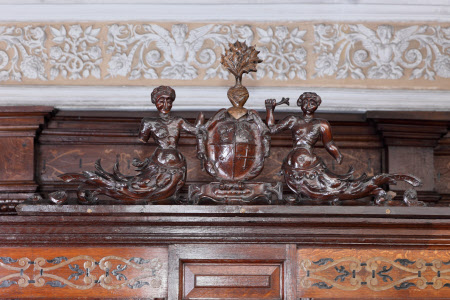Carved moulding
Category
Furniture
Date
1568
Materials
Walnut and oak.
Place of origin
Westmorland (England)
Order this imageCollection
Sizergh Castle, Cumbria
NT 997761.2.2
Summary
A carved walnut and inlaid pediment, England, dated 1568, now atop the cornice of the tester of the bed in the Inlaid Chamber [NT 997761.1] but not original to the bed, and reset from elsewhere. Carved to one-side only, and centred by a shield bearing the quartered arms of Strickland, beneath their holly bush crest. A strapwork cartouche below, centred by an elongated oval boss, inlaid with the date 1568. The supporters both 'merfolk', with foliate scrolling tails. Damaged and with elements lacking.
Full description
Carved to one-side only, and centred by a shield bearing the quartered arms of Strickland, beneath their holly bush crest. A strapwork cartouche below, centred by an elongated oval boss, inlaid with the date 1568. The supporters both 'merfolk', with foliate scrolling tails. Damaged and with elements lacking. This pediment is one-sided and therefore probably was once part of an overmantel, now vanished. Ian Goodall, who made a study of the progression of building works at Sizergh, suggests that it may have come from an overmantel in the Stone Parlour, a room which was re-modeled in the 1740s. It is certainly of a piece with the other 1560s woodwork from that part of the house, and is not particularly in keeping with the decoration to the Inlaid Chamber which is slightly later in date. Its dated elongated oval boss is similar to those to the other dated furniture in the house, and it was probably made by the same craftsmen who are, at present, believed to have been Flemish. Wells-Cole, however, has suggested that some of the woodwork might be attributable to a school of carvers native to Newcastle. The 'merfolk' supporters, with foliate tails, seem to derive from Italian designs of 1530 by Agostino Veneziano and Antonio Salamanca. One of their frieze designs incorporates an highly similar merman with rounded stomach, drop-waisted foliate skirt, and foliate scrolls occurring in the same places along the line of the skirt. It is not known when the pediment was added to the bed, but the bed has been much restored, and altered in the late 18th or early 19th centuries. A 1785 inventory of the room lists 'a Venerable Old Oak Carved bed with Teaster & headboard and Posts all repair'd 1779 by Abreham Story Cabinetmaker'. He probably renewed the paneled oak plinths with oak, and re-worked the canopy and tester (the original tester may be on NT 998027) and possibly inlaid the frieze to match the room's paneling, except that the 'inlay' used here is linseed oil putty. After these repairs, and probably in the early 19th century, the bed was decked out with red moreen hangings which survive today. The bed, and this pediment, were sold to the South Kensington Museum in 1896 for £400, and joined the paneling on display in the West Wing of the Museum, which had been sold five years earlier for £1000. (Megan Wheeler, October 2016)
Provenance
Probably commissioned by Walter Strickland (1516 - 1569) and/or Alice Strickland (c. 1520 - 1588). Sold, with the bed upon which it sits, and the stained glass roundels to the window to the Inlaid Chamber, to the South Kensington Museum in 1896 for £400. Returned to Sizergh on a long loan in 1978. Transferred back to the ownership of the National Trust in 2016.
References
Wells-Cole 1997 Anthony Wells-Cole, Art and Decoration in Elizabethan and Jacobean England: the influence of continental prints, 1558-1625, New Haven & London 1997, p. 21 Goodall, 2002: Ian Goodall. “Privacy, display and over extension: Walter Strickland’s rebuilding of Sizergh.” Antiquaries Journal 82 (2002): pp.197-245.
